15+ Email List Building Strategies
If you’re running a business, blog, or ecommerce store, you know your email list is your golden ticket. It’s not just a list of names, it’s your direct line to people who actually want to hear from you. No algorithms, no gatekeepers, just you and your audience.
And in 2025? Email’s still king, with a jaw-dropping $68 ROI for every buck spent, according to Omnisend’s data on US merchants
But here’s the rub: building that list ain’t always easy. Maybe your sign-up forms are gathering dust, or you’re stuck begging for scraps on social media. Sound familiar?
I’ve been there, staring at a stagnant subscriber count, wondering why nobody’s biting. But after years of testing (and a few facepalms), I’ve cracked the code on growing an email list that’s not just big, but engaged. Below, I’m sharing 15 proven strategies to explode your email list in 2025.

Let’s dive in.
Contents
Why Email List Building Is Your Superpower
Before we get to the good stuff, let’s talk about why email list building is worth your time. Social media’s great for cat videos, but it’s a rented apartment, you don’t own it. Platforms like Instagram or TikTok can throttle your reach or vanish overnight (remember Vine?). Your email list? That’s your house. You control it, and nobody can take it away.
Here’s the deal:
- Insane ROI: Email delivers 760% more revenue with segmented campaigns. That’s not a typo.
- Direct Access: 4 billion people check email daily. Your message lands right in their inbox, not buried in a feed.
- 2025 Trends: AI’s making personalization scary-good, mobile opens are at 60%, and GDPR compliance is non-negotiable.
Still think email’s dead? Nah, it’s just warming up. But to make it work, you need a list full of people who actually care. Let’s build one.
The Power of Owned Marketing
Unlike social media, where algorithms play favorites, your email list is yours to nurture. Every subscriber is a potential customer, and with the right strategies, you can turn casual readers into raving fans.
Social media’s a slot machine, sometimes you win, but the house always has the edge. Email’s a vending machine: put in the work, get predictable results. Plus, 81% of small businesses say email’s their top channel for customer acquisition.
Trends to Watch
AI-driven pop-ups, mobile-first designs, and stricter privacy laws are shaping the game. Stay ahead, and you’ll build a list that’s not just big, but bulletproof.
15 Proven Email List Building Strategies
Here’s the meat: 15 strategies that’ll turn your email list from a ghost town into a thriving community. Each one’s got a clear why, a do-this-now tip, and a real-world example to prove it works. Let’s roll.
Strategy 1: Optimize Pop-Up Forms for Conversions
Pop-ups get a bad rap, but they’re conversion machines when done right. Studies show they convert 3 – 11.09% of visitors. The trick? Timing and design. Nobody likes a pop-up that screams “GIVE ME YOUR EMAIL!” the second they land on your site.
Do This: Set exit-intent pop-ups to trigger when someone’s about to bounce (e.g., after 7 seconds or 50% scroll). Keep forms simple, one field for email, a clear CTA like “Get the Goods.” Offer a quick win, like a discount or guide.
Example: Optinmonster’s pop-up nails this. It feels fun and persuasive but not pushy. Conversions? No doubt through the roof.
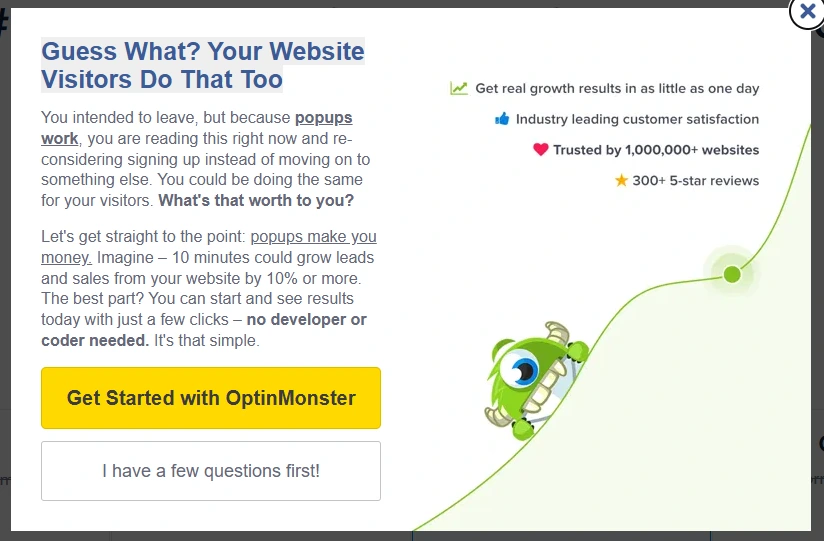
Source: optinmonster.com
Strategy 2: Create Compelling Lead Magnets
Want people to hand over their email? You’ve gotta give ‘em something they can’t resist, something that solves a problem faster than a double espresso on a Monday morning. Lead magnets like ebooks, templates, or cheat sheets are your best bet.
Why? They deliver instant value. Think about it: a fitness coach offering a ‘7-Day Fat-Burning Meal Plan’ PDF, or a graphic designer sharing a ‘Top 10 Canva Templates for Non-Designers.’
These goodies tackle a pain point right away, making folks eager to trade their email for the fix. For example, a food blogger might drop a free ‘Holiday Cookie Recipe Guide’ during December… bam, thousands of sign-ups from baking enthusiasts. The key is to keep it hyper-relevant to your audience and dead simple to access. Make the offer so good they’d feel dumb saying no, and watch your list grow like weeds after a rain
Do This: Craft a niche-specific magnet. If you’re a food blogger, offer a “10 Vegan Recipes Under 15 Minutes” PDF. Keep it valuable but quick to consume, no 200-page manifestos.
Example: Minimalist Baker’s recipe ebook is a masterclass. Their blog posts tease a free download, and the sign-up form’s dead simple. Result? Thousands of foodie subscribers.
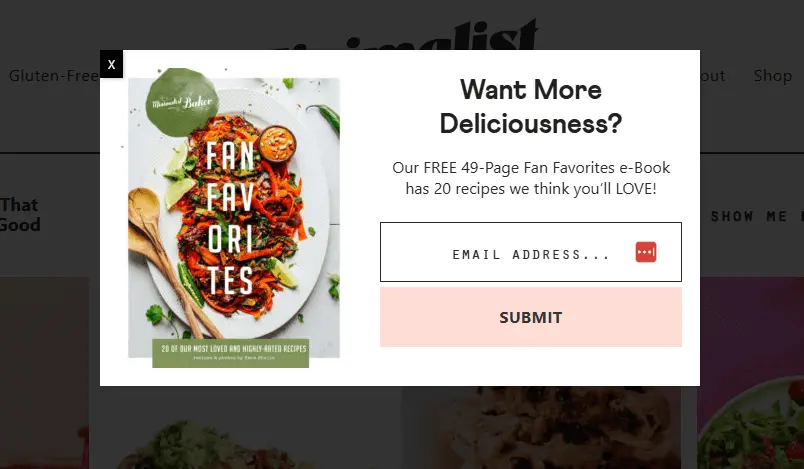
Source: minimalistbaker.com
Strategy 3: Leverage Social Media Profiles
Your social media’s a goldmine for list building—if you know how to play the game. Forget praying for the algorithm to throw you a bone; you’ve gotta take control and drive those followers straight to your sign-up form. Platforms like Instagram, TikTok, or LinkedIn are perfect for this. Stick a link in your bio that screams value—something like ‘Grab My Free SEO Checklist’ or ‘Get Your 5-Minute Morning Routine Guide.’ Make it a no-brainer for them to click.
For example, a fitness influencer might post a killer workout clip on Instagram, then say, ‘Want the full 30-day plan? Link in bio to get it free.’ That kind of teaser pulls followers in like moths to a flame. Or on LinkedIn, a marketing pro could share a quick tip about email campaigns, then direct folks to a sign-up form for a deeper guide.
The trick is to post content that hooks ‘em, then use your bio link to reel ‘em in with a juicy offer. Done right, your social profiles can funnel a steady stream of subscribers without breaking a sweat.
Do This: Add a link-in-bio form via Linktree or Shopify Forms. Make the landing page a no-brainer offer, like a free guide or discount. Update your bio to scream value: “Grab my free SEO checklist!”
Example: Katelyn Bourgoin’s LinkedIn profile is a list-building machine. Her bio links to a newsletter sign-up with a promise of marketing gold. It’s simple and effective.
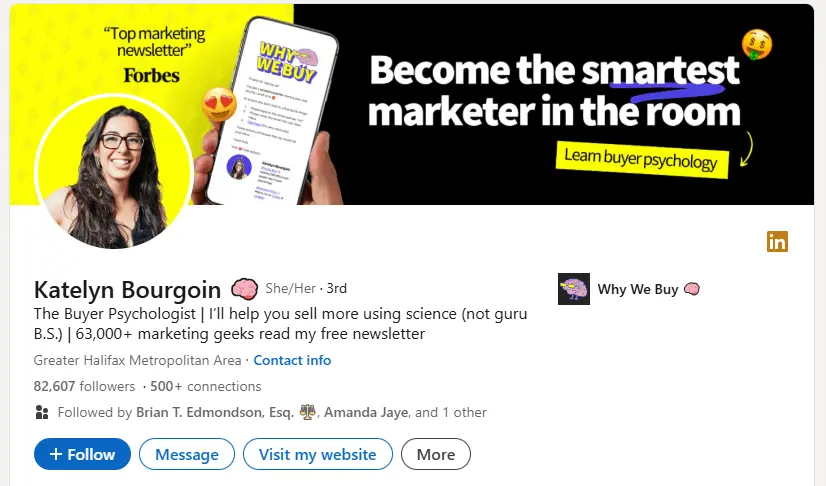
Source: LinkedIn Page
Strategy 4: Use Content Upgrades
Content upgrades are like lead magnets on steroids—they’re so targeted, readers can’t help but say, ‘I need that!’ These are page-specific bonuses tied directly to your blog post’s topic, making them irresistible to anyone already hooked by your content.
Say you’ve got a post about ’10 Ways to Boost Your SEO Rankings.’ A content upgrade could be a downloadable ‘SEO Audit Checklist’ that readers can grab by dropping their email. It’s hyper-relevant, so they’re practically begging to sign up. Or imagine a post on ‘How to Plan a Budget Wedding’—offer a ‘Printable Wedding Budget Spreadsheet’ as the upgrade. Keep the offer specific, valuable, and tied to the post’s promise, and you’ll see your sign-ups climb faster than a squirrel on Red Bull.
Do This: Add a PDF checklist or bonus content to your blog posts. For a post on SEO, offer a “20-Point SEO Audit Checklist.” Embed the form in the post with a bold CTA.
Example: Backlinko’s content upgrades are legendary. Their SEO posts offer downloadable PDFs that readers can’t resist, driving massive sign-ups.
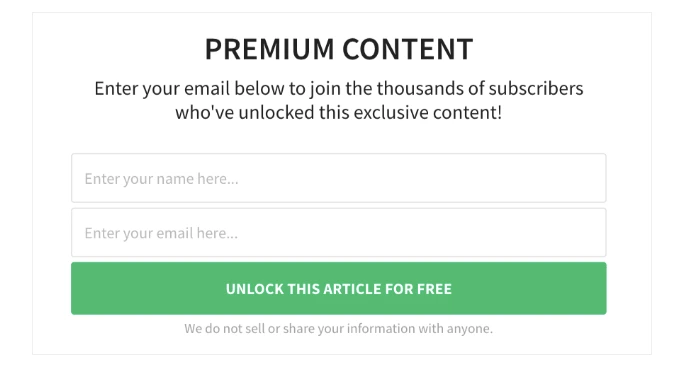
Source: backlinko.com
Strategy 5: Build Strategic Partnerships
Why grow your list alone when you can team up and double your reach? Partnering with complementary brands is like getting a VIP pass to new audiences who already vibe with what you’re about.
The idea is to find a non-competing business in your niche and join forces on something that benefits both your crowds. Think co-hosted webinars where you each bring your expertise—like a fitness coach and a nutritionist teaming up for a ’30-Day Wellness Challenge’ webinar, requiring email sign-ups to join. Or run a joint giveaway: a beauty brand and a skincare blogger might give away a curated ‘Self-Care Bundle,’ splitting the new subscriber list down the middle.
Cross-promotions work too—say, a pet store and a dog trainer swap shoutouts in their newsletters, each linking to the other’s sign-up form with a sweet offer like a free guide or discount. The key is to pick a partner whose audience matches your ideal subscriber, then create something so valuable they’d be nuts not to join in. It’s a win-win that can flood your list with fresh, engaged subscribers.
Do This: Find a non-competing brand in your niche and propose a co-hosted webinar. Promote it to both audiences, with a sign-up form as the entry point. Split the leads.
Example: KlientBoost partnered with a sun hat brand for a bikini campaign. The cross-promotion funneled thousands of emails into both lists.
Strategy 6: Implement Interactive Quizzes
Quizzes are fun, shareable, and get people to hand over their emails faster than you can say ‘What’s your personality type?’ Why do they work? Because folks love learning about themselves, and a good quiz feels like a game, not a sign-up form.
Picture a beauty brand creating a quiz like ‘What’s Your Perfect Skincare Routine?’—users answer a few questions about their skin type and habits, then drop their email to get personalized product recs. Or a travel blogger might offer ‘Which Dream Destination Matches Your Vibe?’ with results like ‘You’re a Bali Adventurer!’ tied to a free packing list.
To make it happen, use a tool like Typeform to build the quiz, keep it short (5–7 questions), and make the results so intriguing they can’t resist sharing. Gate the results behind an email form, and promote it on social media with a teaser like ‘Take the quiz to find out!’
Do This: Create a personality quiz with Typeform (e.g., “What’s Your Skincare Type?” for beauty brands). Gate the results behind an email form. Promote it on social.
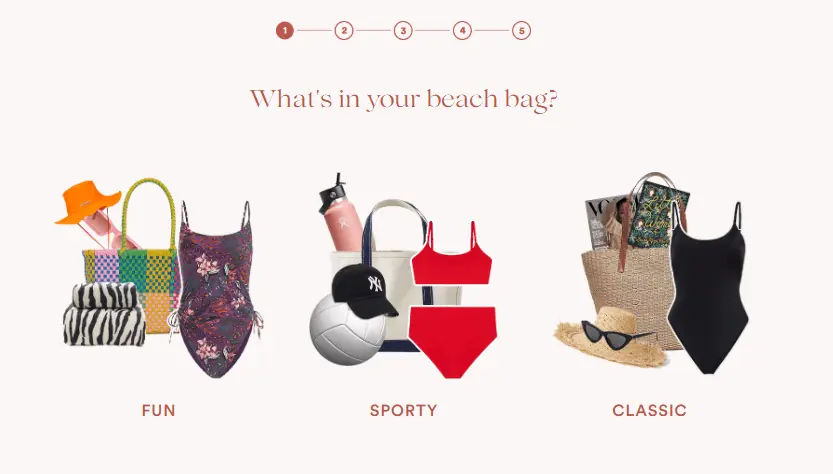
The end of the quiz has the step to sign-up.
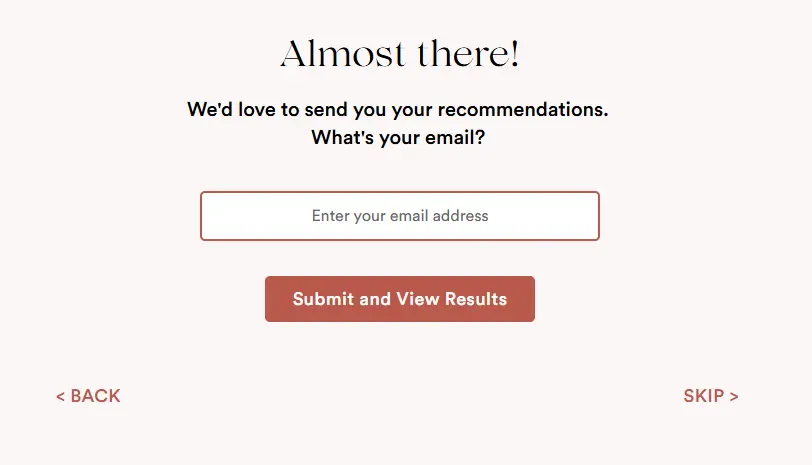
Source: andieswim.com
Strategy 7: Gamify Sign-Ups
Gamification turns sign-ups into a game, and who doesn’t love a little fun? Think spin-to-win pop-ups or contests that make people feel like they’re winning a prize, not just subscribing to another list.
Picture this: a visitor lands on your ecommerce store, and a pop-up says, ‘Spin the Wheel for a Surprise Discount!’ They spin, land on a 10% off coupon, and all they need to do is drop their email to claim it. Or maybe you run a contest—’Enter to Win a Free Month of Our Meal Prep Service!’—and collect emails as part of the entry form.
The magic here is psychology: people get a dopamine hit from the game, so they’re more likely to engage than with a boring ‘Sign Up Now’ form. Tools like OptinMonster make it easy to set up these gamified pop-ups, and you can customize the prizes to fit your brand—think discounts, freebies, or exclusive content. Keep it light, make the reward worth their while, and watch your sign-up rates soar like a kid on a sugar rush.
Do This: Add a spin-to-win pop-up with Omnisend. Offer a different discounts or freebies as the prize. Keep it low-pressure: “Spin for a Surprise!”
Example: Omnisend’s spin-to-win pop-ups are everywhere in ecommerce. They’re fun, non-intrusive, and drive sign-ups without annoying visitors.
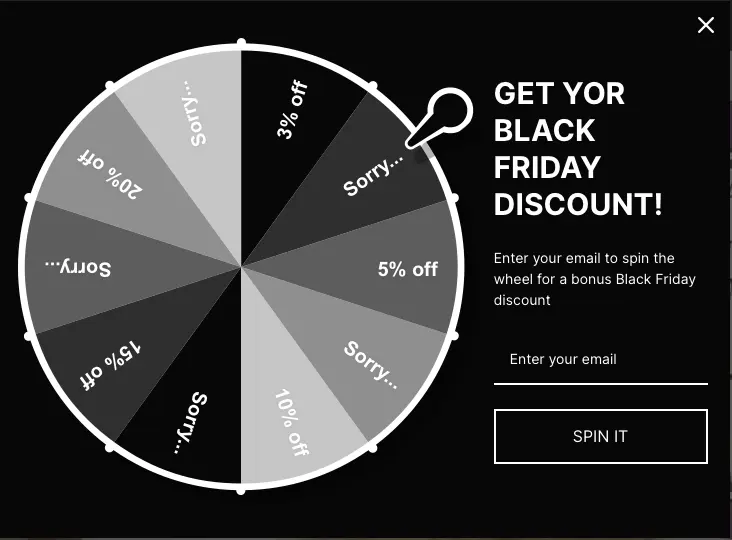
Source: omnisend.com
Strategy 8: Collect Emails Offline
Not everything’s digital, and if you’re sleeping on offline sign-ups, you’re missing a trick. For local businesses or anyone hitting up events—like markets, conferences, or even a pop-up shop—collecting emails in person can seriously juice your list.
Constant Contact swears by this for small businesses, and it’s easy to see why: it’s a personal, no-pressure way to connect with folks who are already interested in what you’re selling. You can also get creative—say, a coffee shop hosting a local art show could have a sign-up sheet for a ‘Free Coffee Tasting Event,’ turning casual visitors into subscribers without breaking a sweat.
Do This: Set up an iPad with a Shopify Forms app at your store or event. Offer a quick incentive, like a coupon for signing up. Keep it simple: name and email.
Example: Constant Contact’s event sign-up forms let businesses collect emails at markets or conferences. It’s old-school but effective.
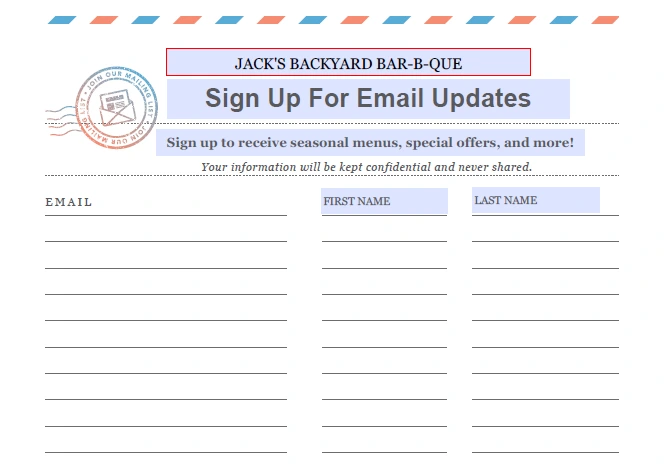
Source: constantcontact.com
Strategy 9: Segment Your List Early
A big list is nice, but a targeted list is money. Segmented campaigns boost revenue by 760% because you’re talking to the right people. Start segmenting from day one.
Do This: Tag subscribers by interest (e.g., “ecommerce” vs. “blogging”) when they sign up. Use Klaviyo or Mailchimp to set up tags based on form responses.
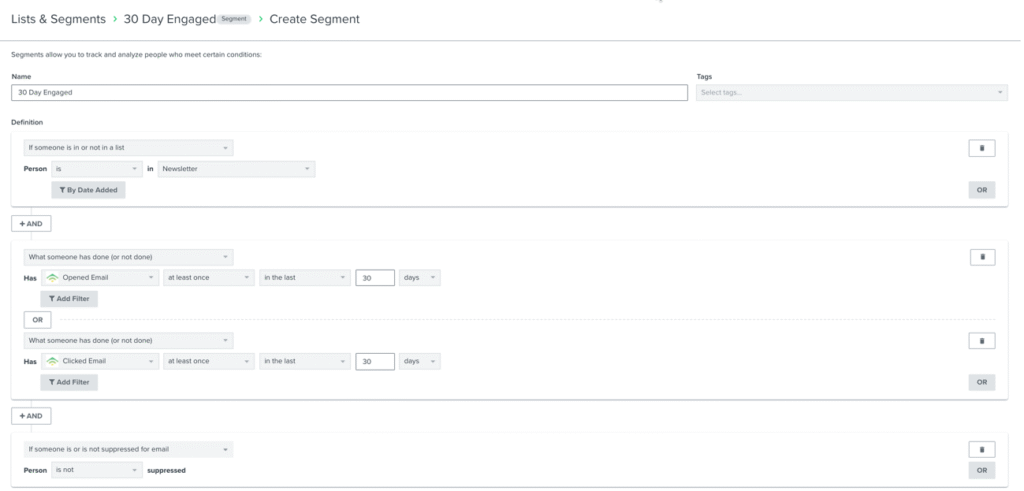
Source: klaviyo.com
Strategy 10: Use AI for Pop-Up Timing
AI’s not just for sci-fi—it’s revolutionizing list building. Tools like Klaviyo use AI to show pop-ups at the perfect moment, boosting conversions by 15%.
Do This: Use Klaviyo’s AI-driven pop-ups to analyze visitor behavior. Let it decide when to show forms (e.g., after viewing two pages). Test and tweak.
Example: Klaviyo’s AI forms adapt to user behavior, showing up when visitors are most likely to convert. It’s like having a psychic on your team.
Strategy 11: Start a Referral Program
Referrals are list-building rocket fuel—turn your subscribers into your personal hype squad! A referral program rewards your existing audience for bringing their friends to the party, and it’s a genius way to grow your list fast. Here’s the deal: you offer an incentive for every new subscriber they refer.
For example, a subscription box service might say, ‘Refer a friend, and you both get 10% off your next box!’ Or a digital marketer could offer a free ebook—’Get My Ultimate SEO Guide when your friend signs up!’
Tools like SparkLoop make this a breeze to set up: they handle the tracking, rewards, and emails so you don’t have to. Promote the program in your welcome email or newsletter with a clear call to action like ‘Share the Love, Win Big!’ The best part? Your subscribers are basically vouching for you, so the new folks they bring in are already primed to trust you.
Do This: Set up a referral program with SparkLoop. Offer a reward (e.g., a free guide) for every friend who signs up. Promote it in your welcome email.
Example: SparkLoop’s referral forms make it easy for subscribers to spread the word, turning your audience into your marketing team.
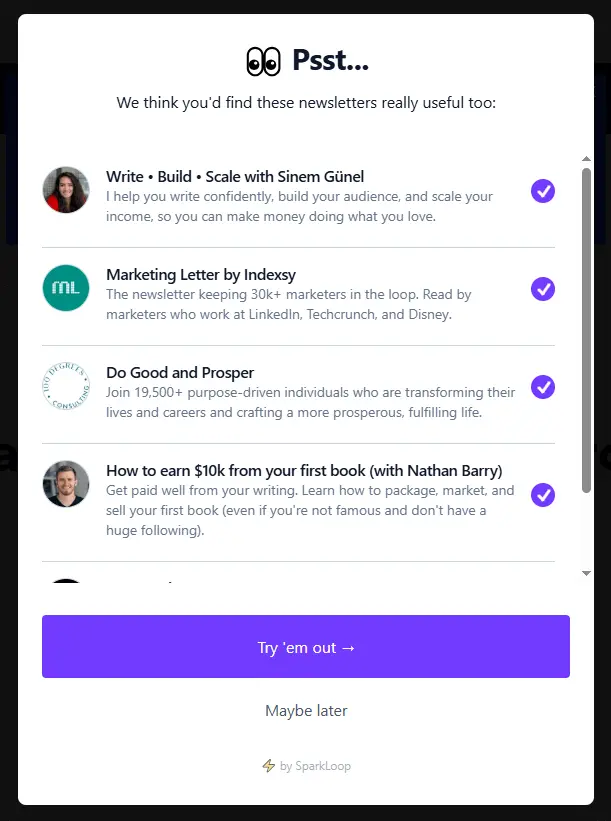
Source: sparkloop.app
Strategy 12: Run Paid Social Ads
Paid ads aren’t cheap, but they’re precise. Facebook Lead Ads let you capture emails without sending people to your site, and they convert like gangbusters.
Do This: Create a Facebook Lead Ad with a lead magnet (e.g., “Free Marketing Plan Template”). Target your ideal audience and keep the form short.
Example: Omnisend’s Facebook Lead Ads drive high-quality leads for ecommerce brands. They’re simple, targeted, and effective.
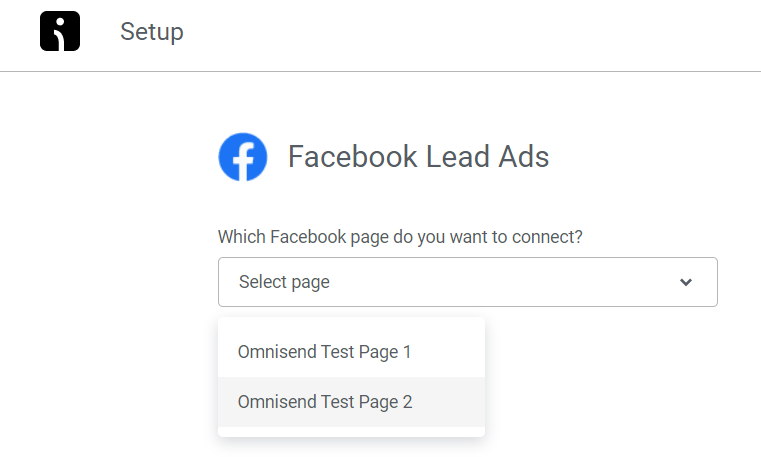
Strategy 13: Host Webinars
People love live, valuable content, and webinars deliver that in spades, making them a great way to grow your email list. Here’s how it works: you host a free online session on a topic your audience can’t resist, like ‘SEO Secrets for 2025’ for digital marketers or ‘How to Meal Prep Like a Pro’ for busy parents. To join, they’ve gotta sign up with their email—bam, they’re on your list.
Partner with a tool like Wistia to set up the registration page and automate reminders, so you’re not sweating the details. Promote it on social media, your blog, or even through a partner’s audience to max out attendance.
The real magic?
Webinars let you show off your expertise live, building trust fast—attendees are way more likely to stick around as subscribers when they’ve already spent an hour soaking up your wisdom. It’s a high-value trade: they get knowledge, you get their email, and everyone’s happy.
Do This: Host a webinar on a hot topic in your niche (e.g., “SEO Secrets for 2025”). Use GetResponse or Wistia to collect sign-ups and promote it on social.
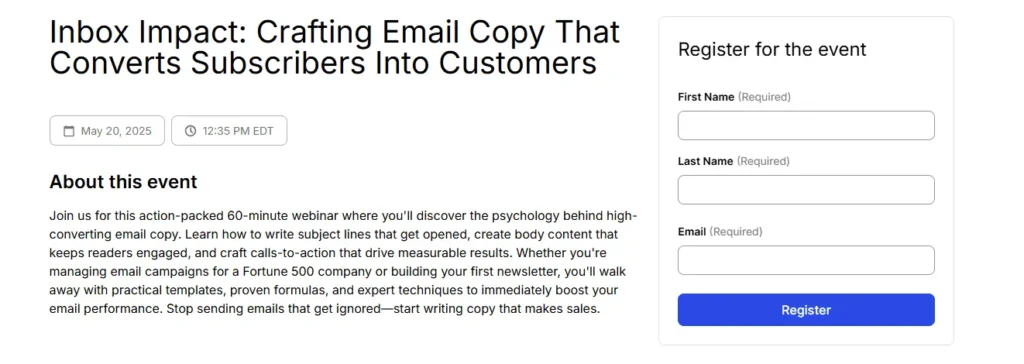
Source: wistia.com
Strategy 14: Optimize for Mobile
With 60% of email opens on mobile, your forms better look good on a phone. Clunky designs kill conversions faster than a bad pickup line.
Do This: Use Mailchimp’s mobile-optimized forms. Ensure buttons are thumb-friendly and text is readable without zooming. Test on your phone first.
Example: Avenova uses Mailchimp’s mobile forms which are clean and intuitive, making sign-ups a breeze on any device.
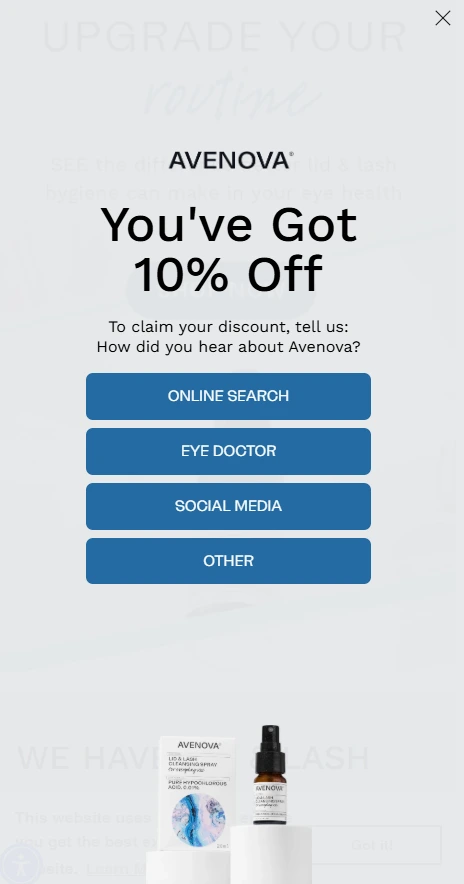
Source: avenova.com
Strategy 15: Ensure GDPR/CAN-SPAM Compliance
Nobody wants a lawsuit with their morning coffee. GDPR and CAN-SPAM compliance builds trust and keeps you legal. Dotdigital says it’s non-negotiable for list health.
Do This: Use double opt-in forms to confirm subscribers. Add a clear privacy policy link to your forms. Tools like Dotdigital make this easy.
Example: Dotdigital’s double opt-in forms ensure subscribers are legit, keeping your list clean and your brand safe.
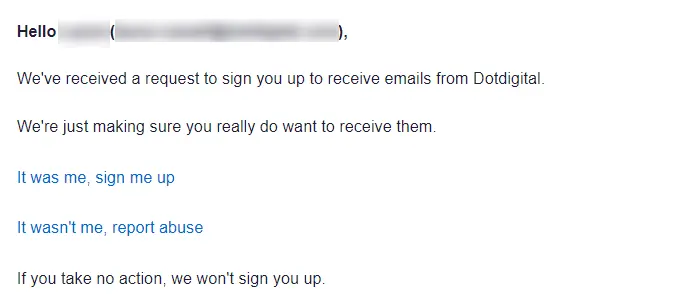
Source: dotdigital.com
Tools to Supercharge Your Email List Growth
You don’t need a PhD to build a killer email list, but the right tools help. Here’s a rundown of the best ones for 2025, plus a quick comparison to pick your winner.
- Shopify Forms: Free, dead simple for ecommerce. Great for pop-ups and checkout opt-ins.
- Klaviyo: Ecommerce powerhouse with AI-driven pop-ups. Starts at $20/month.
- Mailchimp: Beginner-friendly with a free tier (up to 500 contacts). Solid for newsletters.
- OptinMonster: Pop-up king for advanced triggers. Starts at $9/month.
- Typeform: Perfect for quizzes and interactive forms. Starts at $25/month.
| Tool | Best For | Free Tier? | Pop-Ups? | Segmentation? |
|---|---|---|---|---|
| Shopify Forms | Ecommerce | Yes | Yes | Basic |
| Klaviyo | Ecommerce | No | Yes | Advanced |
| Mailchimp | Beginners | Yes | Yes | Moderate |
| OptinMonster | Pop-Ups | No | Yes | Moderate |
| Typeform | Quizzes | No | No | Basic |
How to Choose: If you’re on a budget, start with Mailchimp or Shopify Forms. Ecommerce? Klaviyo’s your jam. Need pop-ups or quizzes? OptinMonster or Typeform. Check our tool reviews for deep dives.
Measuring and Improving Your Results
Building a list is half the battle—making it work is the other half. Track these metrics to know what’s clicking:
- Sign-Up Rate: What percentage of visitors join your list? Aim for 3–5%.
- Open Rate: Are people reading your emails? 20% is solid.
- Conversion Rate: How many subscribers buy or engage? 1–2% is a good start.
Do This: Use Klaviyo or Mailchimp’s analytics to monitor these. Set up Google Analytics to track form conversions (e.g., “thank you” page visits). A/B test everything—pop-up timing, CTA wording, lead magnet offers. OptinMonster says A/B testing can boost conversions by 20%.

Optimization Tips:
- Test pop-up triggers (e.g., 5 vs. 10 seconds).
- Refine lead magnets based on downloads.
- Segment aggressively to boost open rates.
Let’s Wrap This Up
There you have it—15 ways to build an email list that’s not just big, but badass. From pop-ups to quizzes to webinars, these strategies are your ticket to an audience that hangs on your every word. Start with one tactic—say, a killer pop-up—and build from there. The key? Test, tweak, and keep it human. Your subscribers aren’t numbers; they’re people who trust you.
Which strategy’s got you pumped? Drop a comment below—I read every one. Now go build that list and make 2025 your year.









